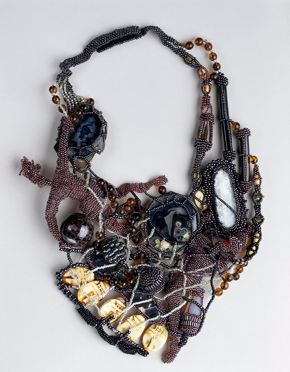“Stay the Course”: An Interview with Artist Joyce J. Scott January 16, 2019

Joyce J. Scott, “Danger Done” Neckpiece, 1994, glass beads, found objects, and thread, the Museum of Fine Arts, Houston, Helen Williams Drutt Collection, Museum purchase funded by the Morgan Foundation in honor of Catherine Asher Morgan. © Joyce J. Scott
Artist Joyce J. Scott. Photo: John D. & Catherine T. MacArthur Foundation
Artist Joyce J. Scott’s work lives at the intersection of craft histories, contemporary art, figurative sculpture, storytelling, and political activism. With interpretive possibilities that are as interconnected and inseparable as the beads she uses in her peyote-stitch weaving technique, it’s no surprise Scott describes herself as thinking in multilayers.
The MFAH collection includes seven of Scott’s works, two of which are on view in Mending: Craft and Community—Selections from the Museum’s Collection. Prompted by Mellon Curatorial Fellow Amarie Gipson’s “Dialogues on Blackness in Contemporary Art” program in July 2018, Kendall DeBoer, the Museum’s Windgate Intern in the summer of 2018, talked with Scott about the complexity and function of her work.
What is your work’s relationship to activism? Do you consider your work activism?
Joyce Scott: It is absolutely activism. The strongest form of social activism occurs one-on-one between human beings. I’m sharing my love for ancient techniques—specifically African and indigenous techniques that are a part of who I am as well as a part of my culture. If someone sees my work, they can see that those cultures have a lot to offer, and that I have a lot to offer. Activism is primary and primal.
Some say your work challenges the concept of jewelry as a wearable decoration. Can you speak a bit on wearability? How do you navigate jewelry as a political medium, considering its history as decoration and excess?
JS: All of my jewelry is meant to be worn. I imagine someone with temerity and chutzpah. You can picture someone dripping in diamonds or wearing a modernist abstraction that is really large and hits you in the eye.
Jewelry as decoration and excess is also specific to the West. Many nonwestern places consider jewelry spiritual or religious. Even in the West, if you’re wearing a cross or the Star of David, that’s spiritual. We just have a different way of talking about it.
How do the materials you use connect your jewelry to narrative?
JS: I come from a long line of storytellers. In storytelling, the body is important because you’re a performer. The body, and its place in society, is much more complicated than the symbols people assign to it. People have many predispositions, but I’m thinking in multilayers all the time. Very few people walk through this world as one thing. My work shows these many layers, which is a human and ethical approach. Horror, comedy, and beauty are inculcated and combined in the human disposition, and that makes me want to talk about it.
Do you have any advice for younger artists?
JS: It’s a different world now than when I started working. We have new technology, the competition is dense, and we’re working with a globally connected population. We are unique in that we are makers, and we create things that mystify and horrify people. I am 70 years old and I have always been looking for challenges and to defy myself. No matter what life gives you, stay the course.
See more in “Mending: Craft and Community,” on view in the Law Building through October 20.





